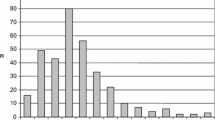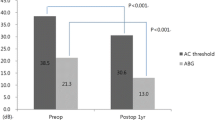Abstract
Background
It is a known fact that bacterial or viral acute otitis media occurs more frequently in the winter months. Only a few older studies on seasonal differences in middle ear findings are available. These studies are based solely on tympanography, without correlation to intraoperative middle ear findings. This study addresses the question of whether seasonal differences can be found in the preoperative tympanogram and in the corresponding intraoperative findings in children with chronic middle ear problems.
Patients and methods
This retrospective study included patients who had undergone myringotomy with or without tympanostomy tube insertion at the Charité–Universitätsmedizin Berlin between January and December 2011. Corresponding to the catarrhal phases, winter months were defined as those from November to April; summer months from May to October. The preoperative tympanogram and the documented intraoperative middle ear finding were statistically analyzed for seasonal differences.
Results
A total of 654 ears from 206 male and 127 female patients with mean age 3.7 ± 2.5 years were analyzed. In the majority of cases, a type B tympanogram was found (n = 376; 57.5%), whereas the middle ear was filled with air in 19.1% of cases. No significant seasonal differences were found for either the intraoperative middle ear findings or the preoperative tympanograms (p > 0.05).
Conclusion
For children with a typical history of chronic otitis media without effusion and chronic tube ventilation dysfunction, myringotomy with or without tympanostomy tube insertion is indicated independently of the season. The results indicate that a wait-and-see approach with hope of improvement during the summer months is not rational.

Similar content being viewed by others
References
Bast F, Frank A, Schrom T (2013) Balloon dilatation of the Eustachian tube: postoperative validation of patient satisfaction. ORL J Otorhinolaryngol Relat Spec 75:361–365. doi:10.1159/000358254
Bluestone CD (2004) Studies in otitis media: Children’s Hospital of Pittsburgh-University of Pittsburgh progress report – 2004. Laryngoscope 114:1–26. doi:10.1097/01.mlg.0000148223.45374.ec
Browning GG, Rovers MM, Williamson I et al (2010) Grommets (ventilation tubes) for hearing loss associated with otitis media with effusion in children. Cochrane Database Syst Rev. doi:10.1002/14651858.CD001801.pub3
Castagno LA, Lavinsky L (2002) Otitis media in children: seasonal changes and socioeconomic level. Int J Pediatr Otorhinolaryngol 62:129–134
Dickson G (2014) Acute otitis media. Prim Care 41:11–18. doi:10.1016/j.pop.2013.10.002
Federal Republic of Germany (1990) German Social Code Book VIII – Child and Youth welfare § 7 para. 1. 1163.
Harmes KM, Blackwood RA, Burrows HL et al (2013) Otitis media: diagnosis and treatment. Am Fam Physician 88:435–440
Henderson FW, Collier AM, Sanyal MA et al (1982) A longitudinal study of respiratory viruses and bacteria in the etiology of acute otitis media with effusion. N Engl J Med 306:1377–1383. doi:10.1056/NEJM198206103062301
Holder RC, Kirse DJ, Evans AK et al (2012) One third of middle ear effusions from children undergoing tympanostomy tube placement had multiple bacterial pathogens. BMC Pediatr 12:87. doi:10.1186/1471-2431-12-87
Holm-Jensen S, Sørensen CH, Tos M (1981) Repetitive tympanometric screenings in 4‑year-old children. Seasonal influence on secretory otitis and tubal dysfunction. ORL J Otorhinolaryngol Relat Spec 43:164–174
Jerger J (1970) Clinical experience with impedance audiometry. Arch Otolaryngol 92:311–324
Knopke S, Irune E, Olze H, Bast F (2014) The relationship between preoperative tympanograms and intraoperative ear examination results in children. Eur Arch Otorhinolaryngol. doi:10.1007/s00405-014-3421-8
Maier S, Tisch M, Maier H (2015) Einsatz der Ballondilatation der Eustachischen Röhre bei chronisch obstruktiven Tubenventilationsstörungen im Kindesalter. HNO 63:686–697. doi:10.1007/s00106-015-0050-5
Mandel EM, Swarts JD, Casselbrant ML et al (2013) Eustachian tube function as a predictor of the recurrence of middle ear effusion in children. Laryngoscope 123:2285–2290. doi:10.1002/lary.24021
Martino E, Di Thaden R, Krombach GA, Westhofen M (2004) Function tests for the Eustachian tube. Current knowledge. HNO 52:1029–1039. doi:10.1007/s00106-004-1152-7
McCormick DP, Baldwin CD, Klecan-Aker JS et al (2001) Association of early bilateral middle ear effusion with language at age 5 years. Ambul Pediatr 1:87–90
German society for ORL (2011) Guidelines chronic otitis media with effusion according to the German society for ORL
Parlea E, Georgescu M, Calarasu R (2012) Tympanometry as a predictor factor in the evolution of otitis media with effusion. J Med Life 5:452–454
Pau HW (2015) Does balloon dilatation represent a breakthrough for Eustachian tube disorders – even in children? HNO 63:681–685. doi:10.1007/s00106-015-0047-0
Poe DS, Pyykkö I (2011) Measurements of Eustachian tube dilation by video endoscopy. Otol Neurotol 32:794–798. doi:10.1097/MAO.0b013e31821c6355
Poe DS, Silvola J, Pyykkö I (2011) Balloon dilation of the cartilaginous eustachian tube. Otolaryngol Head Neck Surg 144:563–569. doi:10.1177/0194599811399866
Rosenfeld RM, Culpepper L, Doyle KJ et al (2004) Clinical practice guideline: otitis media with effusion. Otolaryngol Head Neck Surg 130:S95–S118. doi:10.1016/j.otohns.2004.02.002
Rosenfeld RM, Kay D (2003) Natural history of untreated otitis media. Laryngoscope 113:1645–1657
Schröder S, Lehmann M, Ebmeyer J et al (2015) Balloon Eustachian Tuboplasty (BET): our experience of 622 cases. Clin Otolaryngol. doi:10.1111/coa.12429
Smith N, Greinwald J (2011) To tube or not to tube: indications for myringotomy with tube placement. Curr Opin Otolaryngol Head Neck Surg 19:363–366. doi:10.1097/MOO.0b013e3283499fa8
Stockmann C, Ampofo K, Hersh AL et al (2013) Seasonality of acute otitis media and the role of respiratory viral activity in children. Pediatr Infect Dis J 32:314–319. doi:10.1097/INF.0b013e31827d104e
Tisch M, Maier S, Hecht P, Maier H (2013) Beidseitige Tubendilatation beim Kleinkind. HNO 61:492–493. doi:10.1007/s00106-013-2713-4
Tos M (1984) Epidemiology and natural history of secretory otitis. Am J Otol 5:459–462
Tos M, Holm-Jensen S, Sørensen CH (1981) Changes in prevalence of secretory otitis from summer to winter in four-year-old children. Am J Otol 2:324–327
Tos M, Poulsen G (1979) Tympanometry in 2‑year-old children. Seasonal influence on frequency of secretory otitis and tubal function. ORL J Otorhinolaryngol Relat Spec 41:1–10
Tos M, Poulsen G (1980) Screening tympanometry in infants and two-year-old children. Ann Otol Rhinol Laryngol Suppl 89:217–222
Zehlicke T, Just T, Specht O et al (2011) Tensometry – development of a measurement technique of the tube function in a temporal bone model. Laryngorhinootologie 90:26–29. doi:10.1055/s-0030-1265167
Author information
Authors and Affiliations
Corresponding author
Ethics declarations
Conflict of interest
S. Knopke, A. Böttcher, P. Chadha, H. Olze and F. Bast declare that they have no competing interests.
This article does not contain any studies with human participants or animals performed by any of the authors.
Additional information
Redaktion
W. Baumgartner, Wien
P. K. Plinkert, Heidelberg
M. Ptok, Hannover
C. Sittel, Stuttgart
N. Stasche, Kaiserslautern
B. Wollenberg, Lübeck
Presented in part at the 84th Annual Meeting of the German Society for Otorhinolaryngology, Nuremberg, Germany, May 8–12, 2013.
Steffen Knopke and Arne Böttcher should be considered to share first authorship.
Rights and permissions
About this article
Cite this article
Knopke, S., Böttcher, A., Chadha, P. et al. Seasonal differences of tympanogram and middle ear findings in children. HNO 65 (Suppl 1), 68–72 (2017). https://doi.org/10.1007/s00106-016-0288-6
Published:
Issue Date:
DOI: https://doi.org/10.1007/s00106-016-0288-6




